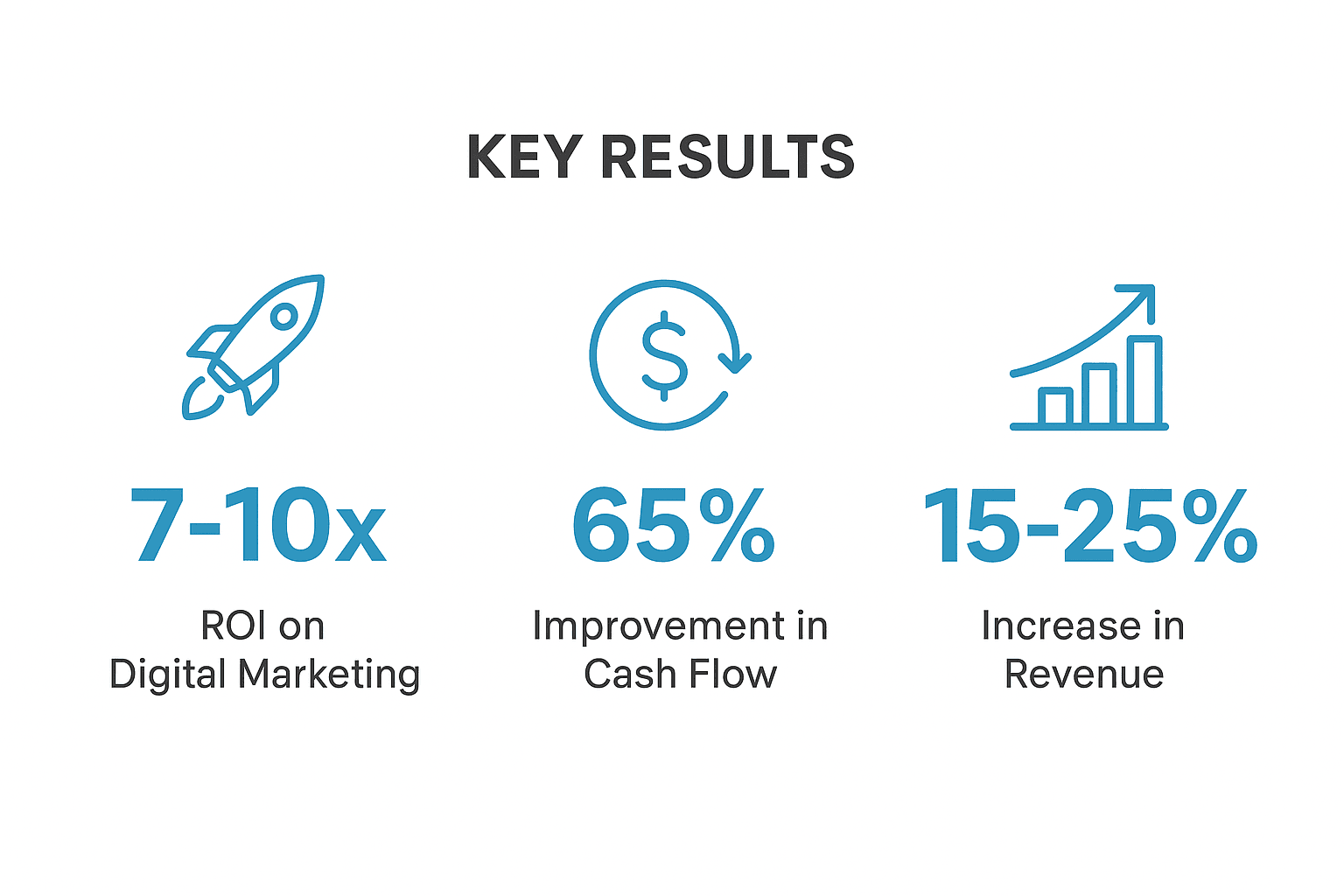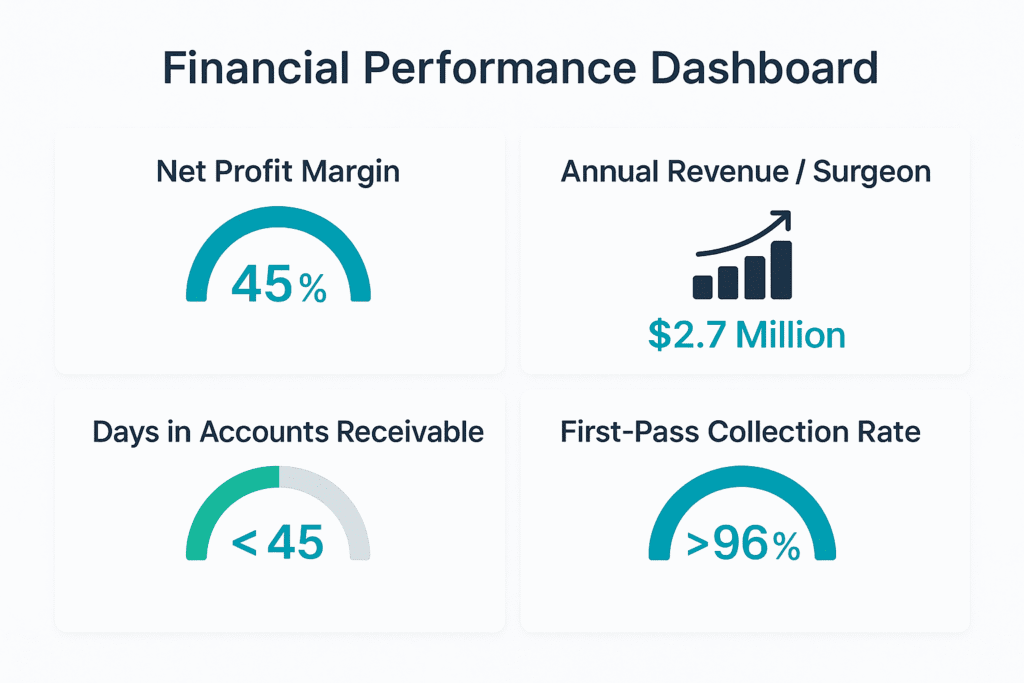
As an orthopedic practice owner or administrator, you are operating in a market with unprecedented potential. But are you capturing your full share of the growth? The most successful practices are achieving remarkable, data-backed results that set them apart from the competition.
This guide is designed to show you how to join them. We will provide the proven growth strategies for independent healthcare practices and financial benchmarks you need to transform your practice, showing you how to achieve:

Success today requires more than your clinical expertise. It demands a systematic business strategy. This guide provides the roadmap to maximize the valuation of your healthcare practice, enhance patient outcomes, and secure your competitive advantage for years to come.
What Are the Most Recent Advances in Orthopedic Surgery?
To stay competitive, your practice needs to embrace the technologies that are transforming orthopedic surgery. These advancements aren’t just about having the latest equipment; they are about delivering measurable improvements in patient outcomes that translate directly into a stronger clinical reputation. You should pay close attention to four key areas:
- Robotic-Assisted Surgery: Once experimental, robotics are now essential for a leading practice. By integrating a platform like Stryker’s Mako system, you can offer surgical precision within 0.5 millimeters, leading to a 15% decrease in postoperative complications and a 25% reduction in hospitalization duration for your patients.
- Artificial Intelligence (AI): AI is revolutionizing diagnostics and treatment. Advanced AI clinical decision support systems (CDSS) can help your team perform assessments at the level of a first-year resident, while predictive analytics can forecast postoperative complications with 71% accuracy, allowing you to intervene proactively.
- Personalized Medicine & 3D Printing: This revolution allows you to offer truly customized care. You can reduce custom implant turnaround times to as little as six weeks, and studies show 55% of surgeons choose a different, often better, surgical approach after using 3D-printed models.
- Minimally Invasive Surgery (MIS): With 68% of orthopedic surgeries moving to ambulatory surgery centers (ASCs), mastering MIS is critical for your practice. These techniques can lead to 20% reductions in your patients’ postoperative pain and enable a 30% faster return to their daily activities.
How to Take Care of Orthopedic Patients: Evidence-Based Excellence
Delivering exceptional patient care means looking beyond the operating room and optimizing your entire patient journey. By implementing systematic protocols and technologies, you can ensure consistent, high-quality outcomes.
- Evidence-Based Guidelines: You can significantly improve patient outcomes and reduce costs by adopting Enhanced Recovery After Surgery (ERAS) protocols. These standardized pathways guide your team on best practices for multimodal pain management and early mobility programs.
- Patient-Centric Care Coordination: Evolve your practice beyond simple scheduling to comprehensive care pathway management. This ensures seamless transitions for your patients between specialists, primary care, and physical therapy, enhancing their experience and strengthening your referral relationships.
- Remote Patient Monitoring (RPM): This technology offers a powerful way to extend your care. With over 25% of the U.S. population expected to use RPM tools by 2025, you can continuously track recovery, detect complications early, and keep your patients engaged. Understanding the different remote patient monitoring revenue models is key to implementing this service profitably.
Proven Strategies for Growing Your Orthopedic Practice
To build a thriving practice, you need a foundation of smart, systematic business strategies. The following four areas will deliver the highest returns for your practice and create a sustainable competitive advantage.
1. Dominate Digital with Search Engine Optimization (SEO)A strong digital presence is the bedrock of modern patient acquisition. SEO, specifically, delivers the most consistent and scalable results for your marketing budget. Consider the transformation of Austin OrthoPartners:
- The Problem: The practice had stagnant patient growth and was over-reliant on expensive traditional advertising with poor returns.
- The Solution: They implemented a dual strategy, combining a targeted local SEO campaign with a marketing liaison program to build physician referrals.
- The Result: In just 18 months, they achieved a 9x return on investment. This was driven by a 400% increase in online appointment requests after securing 55+ first-page keyword rankings.
2. Build High-ROI Referral Relationships: As the case study highlights, digital is crucial, but you can achieve unparalleled efficiency by also investing in a marketing liaison program to build direct relationships with referring physicians.
| Marketing Strategy | Your Budget Allocation | Your New Patient Acquisition |
| Marketing Liaison Program | 8% | 42.7% |
| Traditional Advertising | 92% | 18.7% |
3. Achieve Operational Excellence with Revenue Cycle Management (RCM): Optimizing your revenue cycle is one of the fastest ways to give your practice an immediate and substantial financial boost. A focused effort to improve billing and collections through better healthcare practice management can dramatically improve your cash flow and reduce lost revenue.
- The Impact on Your Practice: Achieve a 96% collection rate at check-in, accelerate your cash flow by 65%, and see a 90% reduction in denied claims.
- Your Timeline: You can typically realize these improvements within 3-6 months.
4. Diversify Revenue with Strategic Ancillary ServicesBy integrating services like physical therapy and imaging, you can enhance patient convenience while creating significant, high-margin revenue streams for your practice.
- Physical Therapy Example: This service alone can generate a median 61% profit margin for your practice.
- Your Overall Revenue Impact: A combined ancillary service line typically increases your total practice revenue by 15-25%.
Strategic Positioning for Maximum Practice Value
The orthopedic M&A market is exceptionally active, creating a time-sensitive opportunity for well-positioned practice owners. To position your practice for a premium valuation, you must focus on the specific value drivers that sophisticated buyers demand.
The Bottom Line: Why This Matters Now With private equity investing heavily in healthcare, top-tier practices are commanding premium valuations, often reaching 13.0x EBITDA. This market activity means that optimizing your practice for value today can have a massive financial payoff in the near future.
Your practice will be evaluated on:
- Your EBITDA: Practices with $2M+ EBITDA consistently command premium multiples. Understanding EBITDA explained for physicians is the first step.
- Your Revenue Diversification: Buyers highly value strong, diversified ancillary revenue from ASCs, PT, and imaging, which are key intangible assets in healthcare
- Your Market Strength: A dominant geographic presence and a favorable commercial payer mix are critical differentiating factors.
- Your Technology Integration: You must demonstrate the use of advanced clinical and operational technology. Finding the right IT/EHR specialists for orthopedic rehab practices is a key part of this.
Beyond these drivers, buyers will scrutinize your financial performance. To be considered top-tier, your practice should meet these financial benchmarks. This often requires working with the best CPAs for orthopedic rehab practices to ensure your books are clean and optimized.

Implementation Roadmap for Sustainable Growth
Achieving this level of success requires a deliberate, phased approach. You can transform your practice by following a 36-month roadmap that balances immediate returns with long-term strategic positioning.
| Phase | Timeline | Your Key Actions | Estimated Investment |
| Phase 1: Foundation | Months 1-6 | RCM optimization, digital marketing launch, staff development. | $100,000 – $300,000 |
| Phase 2: Acceleration | Months 7-18 | Ancillary service integration, geographic expansion planning, advanced tech adoption. | $75,000 – $200,000 |
| Phase 3: Scale | Months 19-36 | Multi-location expansion,strategic partnerships, and performance optimization for M&A. | $100,000 – $400,000 |
The Path Forward: Building Your Competitive Advantage
The orthopedic landscape offers you unprecedented opportunities for growth. The practices that will dominate the next decade are those that master both clinical innovation and sophisticated business operations. This guide provides your roadmap.
The opportunities are significant, and the time to act is now. You must move with urgency to position your practice to capture them.
If you are exploring strategic growth opportunities and M&A positioning for your practice, SovDoc specializes in helping orthopedic practices like yours maximize their value through healthcare M&A advisory services. We invite you to explore how these market dynamics can benefit you. Get connected with an expert now.



